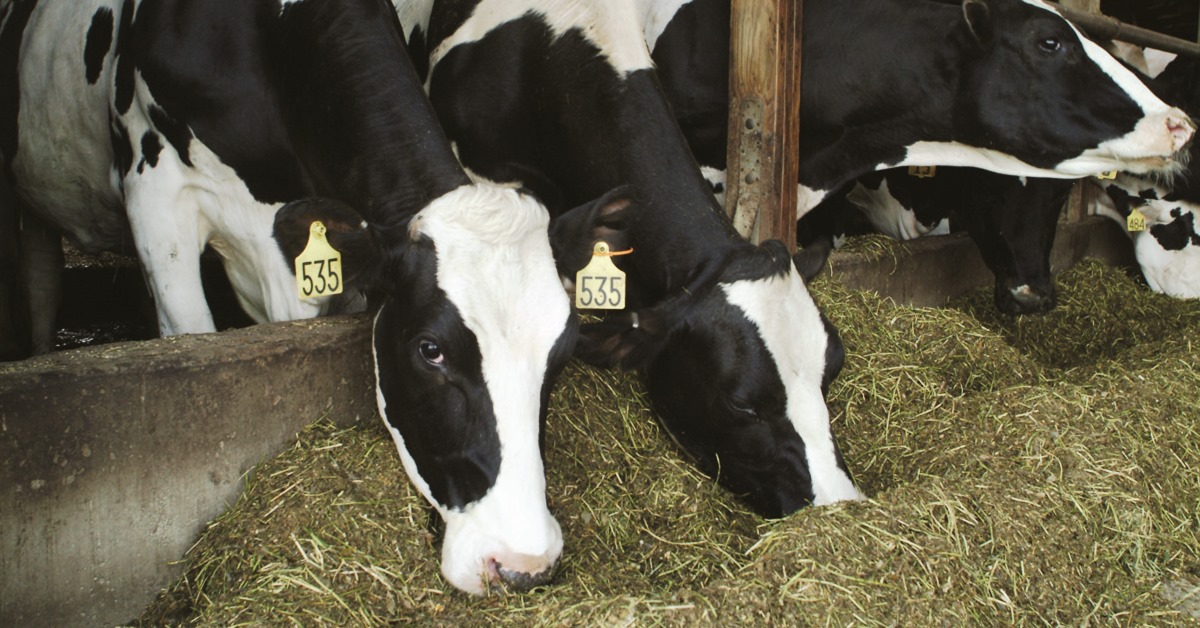
The summer heat is gone, and we are well on our way to the cooler months of the year. With our 2017 forages now in storage, we can evaluate our inventories and focus on inclusion rates for the upcoming year. As forage quality continues to improve, strategies for optimizing dry matter intake on dairy farms keep evolving.
Dry matter intake (DMI) is what delivers the nutrients to the cow in a moisture-corrected format. Increased dry matter intake leads to an increase in digestible nutrients and microbial yield; furthermore, they supply more energy and nutrients to the cow. On the other hand, the negative effects of rumen fill and rate of passage can impact feed intake, the rumen environment (e.g., subacute ruminal acidosis) and health (e.g., ketosis).
Benchmarks of average dry matter intakes are shown below (Table 1). For example, a 1,300-pound, high-producing Holstein cow should be eating approximately 52 pounds of dry matter per day. Lower-producing or late-lactation cows should be eating approximately 3 percent of their body weight, typically around 39 pounds of dry matter. As young stock mature, they eat a smaller percentage of their body weight, although their intakes equate to more dry matter pounds since body weight has increased.
Dry matter intake throughout lactation is illustrated in the graph below (Graph 1). As you can see, DMI (green curve) peaks out shortly after milk production and, as a result, the animal loses body weight. As cows increase in number of days in milk, body weight climbs as milk production and DMI decline. The challenge becomes synchronizing these three curves to optimize on-farm production.
Table 1. Holstein dry matter intake (%BW)
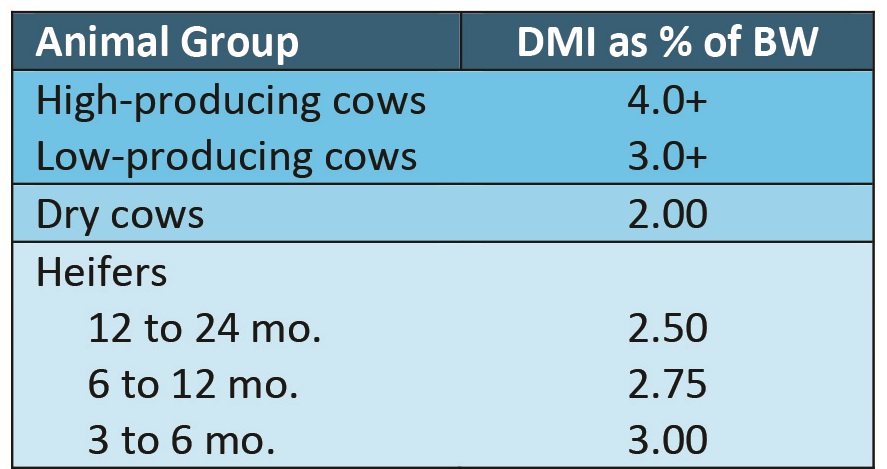
Graph 1. Comparison of DMI, milk production, and body weight
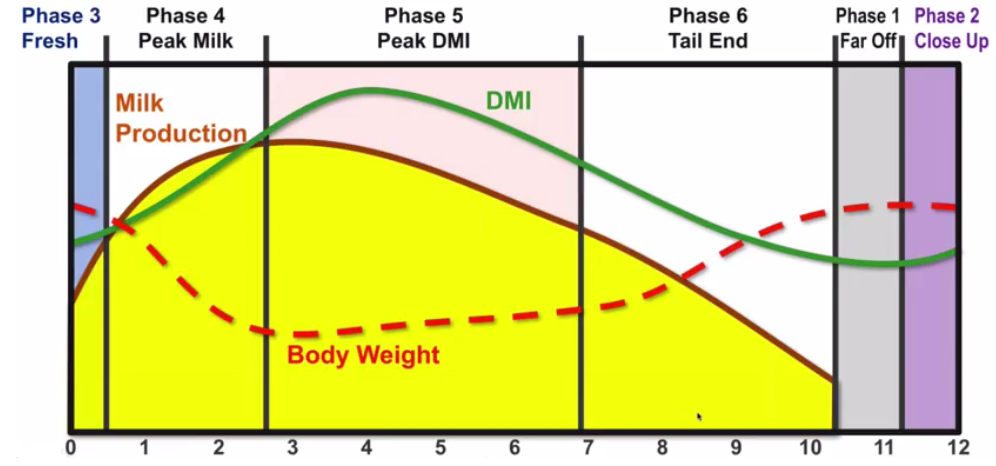
Marginal dry matter intake
The last pound of dry matter intake consumed can support 2 pounds more milk, since the maintenance demand of the cow has already been met. The average cost of 1 pound of dry matter is approximately 10 cents, and the value of 2 pounds of milk is approximately 32 cents ($16/hundredweight). Therefore, profit margin on that extra pound of intake is 22 cents per cow per day. So, you may be asking yourself, what are the strategies to get that extra intake into your high-producing cow, particularly in early lactation?
Minimize sorting to increase dry matter intake
Dry matter intake can be maximized by eliminating concerns with the following considerations.
- Feeding more frequently (if dry matter changes more than 2 pounds)
- Pushing up more frequently (2-pound rule)
- Reduce long forage particle (1 to 2 inches)
- Add water (7 to 15 pounds per cow; targeting a TMR moisture of 45 to 55 percent DM)
- Consider wet molasses (3–4 pounds per cow)
- Remove feed refusals more frequently
Use the Penn State Particle Separator (PSPS) box (Table 2) to monitor variation from delivered TMR
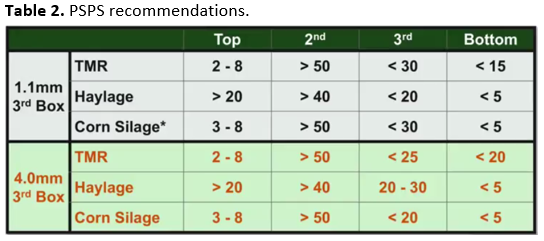
Why do cows stop eating?
The three primary factors that limit intake are illustrated below (Image 1) and include:
- Non-nutrient factors: Intakes are dependent on the cow’s perception of the feeding environment. Negatives that contribute and decrease intakes can include empty bunks, heat stress, lame cows, poor housing and poor cow comfort.
- Metabolic feedback: Something in the ration shuts the cow down (e.g., high fat level, high propionic acid, low rumen pH, mold in the feed, increased mycotoxin load), thereby decreasing intake and limiting available nutrients.
- Physical fill: The cow is full of dry matter before nutrient goals are met; a high level of indigestible fiber, low digestibility of fiber or low-quality forages are being utilized.
Our goal is to remove or minimize each of the three identified factors listed above to maximize intake.
Image 1. Schematic of factors affecting feed intake
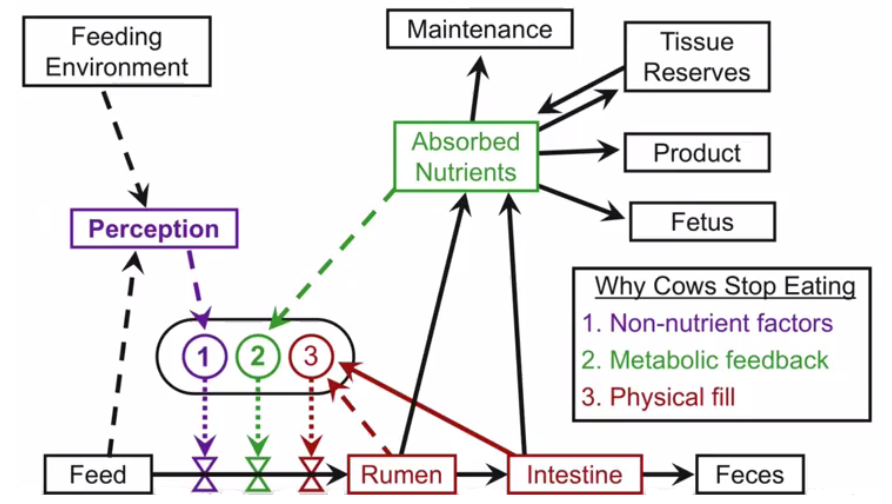
How do I evaluate my herd’s DMI/feed efficiency?
One way to evaluate your herd’s efficiency is to take pounds of fat-corrected milk and divide it by pounds of dry matter consumed. Benchmarks for herds are shown below (Table 3) and listed by stage of lactation.
For example: 80 lb. 3.5% FCM / 50 lb. DMI = 1.6 efficiency
Where 3.5% FCM = (0.4324 x lb. of milk) + (16.216 x lb. of milk fat)
Table 3. Dairy efficiency benchmarks
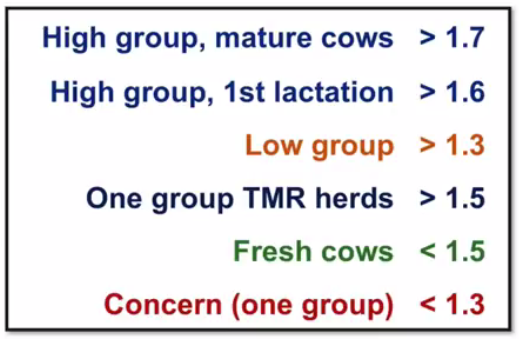
Take-home messages
As you can see, several factors can affect consistent dry matter intakes on our dairies.
- Determine optimal dry matter intake for each group of dairy cattle on your farm.
- While the economics of dry matter directly impact profitability, do not sacrifice performance. Cheap feed does not necessarily translate to more profit.
- Body condition score can reflect energy and dry matter status.
- Dry matter intake impacts growth, fertility, rate of metabolic disorders and longevity.
For questions related to your herd’s dry matter intakes or feed efficiency, reach out to a Hubbard Feeds dairy representative near you.
Source of tables, graph and images: Hutjens. M., 2017. Driving dry matter intake on dairy farms. Hoards Dairyman Webinar. 2017-08-21. https://hoards.com/videos-100-driving-dry-matter-intake-on-dairy-farms.html
- Log in to post comments
